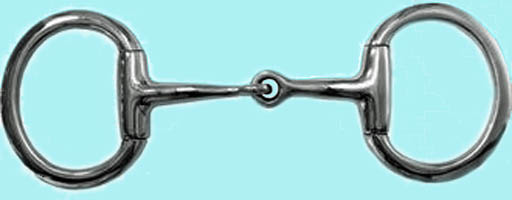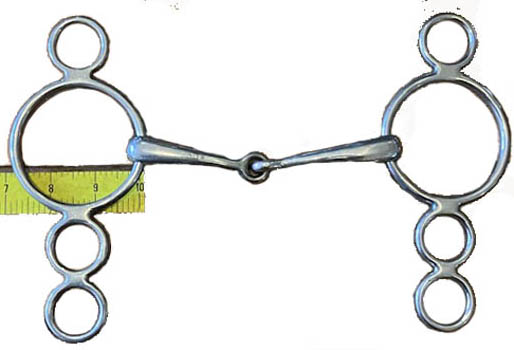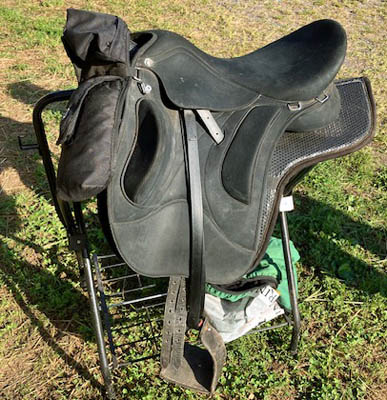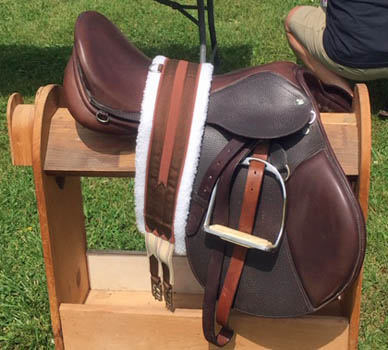Eastern Equine Encephalomyelitis (EEE)
[Veterinary Medicine] Eastern Equine Encephalomyelitis is a mosquito-borne, vaccine preventable, viral infection of a horse's brain and spinal cord. It is generally fatal and can rarely appear in humans. Symptoms include impaired vision, head pressing on available objects (an indication of a headache), circling, incoordination, convulsions and fever.
Eggbutt Snaffle Bit

|
[Equine Equipage] The Eggbutt has a fixed joint between the mouthpiece and oval-shaped rings. An Eggbutt is considered to have a very stable ring there is, allowing little movement that might pinch and thus is more easy for the horse to make contact.
Elevator Snaffle Bit

|
[Equine Equipage] An elevator snaffle bit is a type of snaffle that features additional smaller rings above and below the main ring to which the one or two reins might be attached to provide for more leverage. Those using a elevator mention that when introduced to a horse, the horse often fight it with a lot of head tossing.
Endophytic Tall Fescue (Lolium arundinaceum)
[Toxic Plant to Horses] Tall fescue is a grass species that by itself is no problem. However, it is subject to being colonized by an endophytic, symbiotic fungus species that in turn produces a toxin that affects grazing animals. In mares multiple gestational and parturitional functions are affected. Pregnant mares should never be allowed to gaze on pastures containing endophytic tall fescue.
Endurance Riding
[Equine Competition] A cross country ride in which the competitors are required to complete the ride in a specific time period. Generally, there are check points along the course at which judges check the horse's pulse and respirations for adequate conditioning to proceed. In warmer weather riders carry a sponge on a line and drop it into streams to sponge their mounts. Anyone having a well-exercised mount might consider participating in the lower level competitions. It makes for a good ride, does not require continual cantering and basically to complete the course in time is to win and not that terribly difficult to do. Needless to say, higher level competitions can be grueling, taxing to a horse and best left to individuals who specialize in these events.
Endurance Saddle

|
[Equestrian Equipage] An endurance saddle is a lightweight, comfortable saddle designed for long distance riding. They are used for competitive endurance events and more ordinary trail rides over long distances. They feature extra padding, light weight and extra dee rings to fix items being carried. Various styles exist, including English and Western-like designs..
Engaged
[Equine Schooling] A horse is said to be engaged when it is fully responding to the rider's aids (legs, bit pressure, etc.) and confidently moving with the correct degree of impulsion. When your horse is truly engaged the rider cannot help feeling a sense of pleasure and satisfaction. There is nothing like that in the world.
Engagement of the Hindlimbs
[Equine Movement] Engagement of the hindlimbs refers to a horse keeping the hindlimbs under its body and shifting its balance so that more of its body weight is carried in the hindquarters. We humans, being bipeds, do not consider this but a horse is configured somewhat like a bridge. Its weight is suspected between its fore legs and hind legs. When one of a horse's hind legs is trailing during movement all its rear body weight, which its most of the body weight, is carried by the other leg. That does not allow for a lot of maneuverability. What engagement of the hindlimbs means is to train the horse to keep the hindblimbs under its body and supporting the body weight in preparation for some other movement, often a pivot. With a signal for impulsion the horse is able better to spring out of this engagement. This is particularly important in Western riding, for example in a cutting horse, or in dressage.
English

|
[Riding Style] A style of riding first practiced in the British isles among hunters and often used in contrast to Western riding in North America. English riding equipment and the manner of riding is distinct from other riding styles. An individual horse may be taught any style of riding but those practicing various styles often tend to favor certain breeds.
Enterolith
[Veterinary Medicine] An enterolith is a hard mass that forms around a foreign body that has gotten into a horses gastrointestinal system. They can be a cause of colic and some require surgical removal.
Eosinophilic Granuloma Complex
[Veterinary Medicine] Eosinophilic granuloma complex is the most common nodular skin condition in horses. The etiology is uncertain but insect bite reactions is often put forward. I suspect that the complex cannot be thought of as a single disease, but rather a collection of different ones and this is implied by the word complex. The presentation varies considerately with multiple nodular lesions present in the skin and sometimes grouped in specific locations, typically neck, trunk and back.. The size of the lesions are variable between different horses. Treatment is high dose steroids. The condition is difficult to treat and the prognosis is often cited as "guarded." The word "guarded" suggests rather bad, but some sources are more optimistic.
Epsom Salts (Magnesium Sulfate Crystals)
[Veterinary Medicine] Epsom salts dissolved in warm water is often used for soaking an abscessed hoof. The scientific evidence supporting its effectiveness is limited. The hypertonic nature of the solution may pull fluid out of the wound and serve to help clean it. However, it can be very difficult and time consuming to keep a horse's hoof clean. Hoof abscesses are very common in horses and most owners find they must deal with them more than a couple times.
Equestrian
[Terminology] An Equestrian is a person who rides horses or a matter pertaining to horses.
Equestrienne
[Terminology] An Equestrienne is an old term for a female who rides horses. I cannot remember if I have seen it in print in memory. Like the perfectly understandable word actress, it was disappeared from the lexicon.
Equidae
[Equine Taxonomy] Equidae is the taxonomic family name in the classification of animals comprising horses, asses and zebras. Members of the family share a basic body contour, are grass eating and have a single-sheathed hoof on which they walk.
Equidae
[Equine Taxonomy] Equidae is the taxonomic family name in the classification of animals comprising horses, asses and zebras. Members of the family share a basic body contour, are grass eating and have a single-sheathed hoof on which they walk.
Equine Ambulance

|
[Veterinary Medicine] There are specially equipped and staffed horse ambulances that deal with horse emergencies. These are voluntary organizations that are based in areas where here is a lot of horse related activities taking place. It is commonplace to see one positioned at major competition events and backing up the site's veterinarian. If necessary, they will transport an injured or seriously sick horse to the nearest horse veterinary center trauma room. The ambulances are equipped with screens that give the horse and rider privacy as the vets deliver necessary care. There are things that animal-loving spectators should be spared from seeing. Their supporting team often conducts worthwhile clinics in equine emergencies for horse owners.
Equine Encephomyelopathies
[Veterinary Medicine] The equine encephomyelopathies are a class of similar diseases caused by arboviruses and spread by mosquitoes from reservoir species, often birds or rodents. The principle types in the U.S. are Eastern, Western and Venezuelan equine encephalitis. Human beings can rarely acquire these diseases as well. They are vaccine preventable but once the infection is acquired they have a high mortality.
Equine Grass Sickness (Equine Dysautonomia or EGS)
[Veterinary Medicine] Equine grass sickness is a disease characterized by damage to the autonomic nervous system, leading to gut paralysis. Its presentation is similar to forms of colic. It seems to occur when horses are placed on rich green grass and there is speculation that poorly characterized neurotoxin is at fault. An occasional horse survives a mild case. No specific treatment is known. The disease is most common in Scotland and I have the impression it is uncommon in the U.S. I am unable to find detailed numbers on the distribution of U.S. cases.
Equine Herpes Virus (EHV)
[Veterinary Medicine] The equine herpes viruses are members of the Herpesviridae family of DNA viruses. There are over 130 different viruses comprising the family, affecting many kinds of animals. These viruses often exhibit a latent stage in which are dormant in their host for long periods of time. There are 9 subfamilies known to infect horses. None of these seem to cause a disease that is transmissible to humans. A common type in horses is Equid Herpesvirus One, which is initially a respiratory infection, sped by inhalation. In addition, certain strains can lead to mares aborting and rarely limb paralysis. There is some value in a vaccine and quarantines with no movements being allowed until 21 days from the infected facility. Another type is Equid Herpesvirus Three, which is a venereal disease, causing blisters and ulcers in the injected animals.
Equine Infectious Anemia (EIA)
[Veterinary Medicine] Equine infectious anemia is caused by the equine infectious anemia retrovirus and transmitted by bloodsucking insects commonly, biting flies from horse to horse. The disease exists in acute, subacute and chronic forms. Some horse have few symptoms but are carriers. In others there is high fever, anemia from breakdown of red blood cells, lethargy, and swelling of the lower abdomen and legs. For infection control infected horses must be quarantined and many are still euthanizing. A hopeful development is the "Chinese Live Attenuated EIA vaccine."
Equine Influenza
[Veterinary Medicine] Equine Influenza is a highly contagious, but rarely fatal respiratory infection of horses, donkeys and mules and other equidae. It is caused by influenza A virus stains. The incubation period is one to three days, and it spreads quickly in a herd. The symptoms include fever, cough, nasal discharge, lethargy and loss of appetite. In 1872 a pandemic occurred that affected all of North America. About 80% of the horse population were ill from it and unable to work. It proved extremely disruptive to transportation in this country and had a great economic cost associated with it.. Most horses will return to normal in two to three weeks. Horses should be routinely vaccinated against equine influenza.
Equine Lordosis (Swayback)
[Veterinary Medicine] A horse that has equine lordosis has a concavity to the line of the spine beginning behind the withers. The impression is that the horse is sagging. It is associated with aging and appears in some breeds, such as American Saddlebreds, more that others. The condition is generally believed not to be painful. However, there is a loss of muscle tone and weakened supporting structures that should be respected in riding the animal. A major issue with riding a swayback is fitting a saddle to conform to the back alignment. Consulting a saddle fitter is a good idea. Burden should be restricted and massage and conditioning exercises are helpful.
Equine Metabolic Syndrome (EMS)
[Veterinary Medicine] Equine metabolic syndrome is a disease of horses, similar to diabetes in humans and characterized by obesity, insulin resistance, higher blood sugar levels and an increased risk of laminitis. Basic treatment is restricting carbohydrates, weight loss and increased exercise. There are special horse feeds formulated for horses with EMS.
Equine Piroplasmosis (Babesiosis)
[Veterinary Medicine] Equine Piroplasmosis is a tick-borne disease caused by the protozoan parasite, Babesia caballi or Babesia equi.. At this point in time, it mainly occurs in animals imported from endemic areas since the particular horse parasite has not gained a permanent foothold in the U.S. It can can be detected by seeing the organism as a ring-like structure within horses' red blood cells. The organism can be killed by certain antimicrobials. Babesiosis in many ways behaves like Lyme disease and a human form of the disease exists but it is caused by different Babesiosis species than the equine form..Equine Protozoal Myeloencephalitis (EPM)
[Veterinary Medicine] Equine protozoal myeloencephalitis is caused by the parasite Sarcocystis neurona and often transmitted by the contamination of feed or water from the feces of wild animals, particularly opossums. The common symptoms of EPM are neurological and include ataxia, general weakness with muscle spasticity. Reflexs are lost and the horse may be unable to lift its tail when defecating. There is a confirmatory blood test and treatment is available. We had an affected horse that was treated, completely recovered and returned to full activity.Equine Recurrent Uveitis (ERU)
[Veterinary Medicine] Equine recurrent uveitis, also called moon blindness, recurrent iridocyclitis or periodic ophthalmia, is an acute and remittent ocular disease that begins in the uveal tract but in time involves all eye structures. Its pathogenesis is incompletely understood but the mechanism likely has an autoimmune basis, perhaps with infectious triggers. It is treatable, but not curable at this time. It is not contagious. Either a single eye or both can be affected and surprisingly belonging to certain breeds or living in certain regions seem to increase risk.
Equine Reflex Hypertonia (Springhalt)
[Veterinary Medicine] Equine Reflex Hypertonia is an acquired neuromuscular condition that causes a gait abnormality, producing an involuntary, exaggerated upward movement of one or both of the hindlimbs. It is worse in cold weather. The horse is not in pain, but this can be an issue when ridden. In extreme cases it might be treated surgically, but surgery is often not successful.
Equitation
[Horse Showing and Riding Term] The art of correct and skilled riding on the part of the rider without regard to the training of the horse. This is often applied to jumping classes at horse shows. Often it takes only a glance of a practiced eye to initially size up a rider's basic abilities.
Equitation Position (Also Dressage Seat)
[Dressage] The Equitation position is one of three principle seat positions in riding. In the equitation position the rider exhibits the correct upper body posture: body slightly back in the saddle as opposed to a forward (hunter's) seat and with the chest open, shoulders down and the reins properly and completely held. For a time, and this is the honest to God truth, the Italian Cavalry School, was instructing its officers to jump while in the equitation position. I have no idea why, but it is no surprise that the exercise was dropped because of the large number of resulting injuries.
Equus asinus
[Taxonomic Classification] Equus asinus is the scientific species name of the donkey or wild ass.
Equus caballus przewalskii
[Taxonomic Classification] Equus ferus przewalskii is the scientific subspecies name of Przewalski's horse. They are also known as the takhi, a word meaning spirt in Mongolian. Small reintroduced herds of them still exist in Mongolia.
Equus ferus caballus
[Taxonomic Classification] Equus ferus caballus is the scientific subspecies name of the modern domestic horse.
Equus giganteus
[Taxonomic Classification] Equus giganteus is the scientific species name of an extinct gigantic horse, whose fossil tooth was located in Texas and described by paleontologist James W. Gidley in 1901. However, what we know of Equus giganteus is based on this single huge tooth. The horse this came from is estimated to have stood 7 feet 5 inches tall at the shoulder and weighted about 3000 pounds. So far, no other confirming remains of a similar animal have been located and the fossil has been placed in a nomen dubium (doubtful) category. I cannot agree with that. A tooth is a particularly revealing and specific finding. For a long time we had only a single tooth of the ancient human species Denisova hominins. Now more remains have been found over a wide area and their DNA has been sequenced.There are places in the U.S. where the ground is literally covered with fossils. They are weathered, fragmented and difficult to identify even when collected and studied in a lab. It is possible that fragments of Equus giganteus are out there right under collectors' noses and are ignored by those paleontologists, whose interests have a different focus. We can only wait this one out.
Equus lambei
[Taxonomic Classification] Equus lambei scientific species name of the Yukon wild horse. They were the last surviving native horse species in North America until they became extinct 10,000 years ago.
Equus quagga
[Taxonomic Classification] Equus quagga is scientific species name zebras. There have been effort to tame Zebras but they have been mostly unsuccessful.
Estrus
[Reproductive Cycle of Mares] That part of the estrus cycle when a mare is sexually receptive (in season). It is triggered by hormonal levels (luteinizing hormone (LH) and estrogen) and ultimately by the amount of daylight in the spring and summer. The total cycle typically lasts for 3 weeks and estrus itself for about one week. The phase during which the mare is unresponsive is called diestrous. There is little doubt that a mare is in season, particularly if you happen to be riding behind one, but I will not describe this farther. At the conclusion of estrus the mare's uterine lining breaks down and is reabsorbed by the body, a process known as covert menstruation. There is no discharge, which nature may have developed to thwart predators.
Eventing (Equestrian Triathlon, Horse Trials, Combined Training)
[Equestrian Disciple and Competition] Eventing consists of three riding disciplines of dressage, cross-country, and show jumping. The sport was previously known as combined training and is one of the Olympic equestrian categories. It requires a good all around rider and gifted horse. The various levels of competition are: beginner novice, novice, training, modified, preliminary, intermediate, advanced, three star international and four star international.
Exmoor Ponies
[Equine Breed] Exmoors are a breed of British ponies native to the Exmoor region of the Counties of Devon and Somerset. They are considered a breed on the brink of extinction with population world-wide of population of about 330 individuals. They nearly became extinct during the Second World War, when unscrupulous individual took many for meat that was otherwise rationed. They also have the highest inbreeding coefficients among all horse breeds, which says a lot when I look at the pedigree of mine own Thoroughbred (reported as about 13% among all). Exmoors are felt to be somewhat less than 20%. They typically have dark bay coat color, ample mains and tails and other marking that are classified as being primitive. They have a high frequency of pre-domestication mitochondrial DNA-haplotypes, suggesting they are a truly ancient breed.
Extension

|
[Equine Gaits] Extension is the act of a horse deliberately lengthening the distance that its steps during a particular gait. The gait is then referred to as a extended walk, extended trot, etc. This can be seen most graphically during dressage competitions. The opposite of extension is called collection. In most riding situations riders do not care how extended or collected their horses are. An excited horse may naturally go into an extended gait, particularly if the rider keeps a firm pressure on the bit but not so much as to shift to a slower gait.